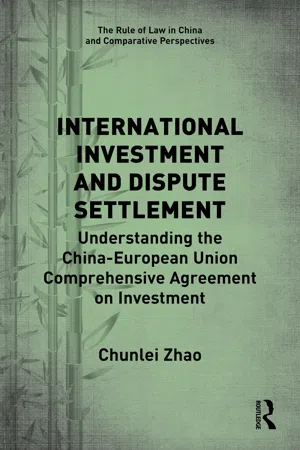China and the EU are two of the world’s biggest players in the area of international investment. Besides the large volumes of foreign direct investment inflows and outflows, both of them have been active in negotiating and concluding international investment agreements. These treaties provide diverse investment protection as well as mechanisms for addressing the disputes arising therefrom.
2.1 China’s International Investment Treaty Practice
As of June 2021, China has signed 145 BITs (107 in force) and 24 other investment agreements (19 in force), and the most recent one is the Regional Comprehensive Economic Partnership (RCEP) signed on 15 November 2020. Along with these international agreements on investment, China has also adopted four Model BITs in 1984, 1989, 1997, and 2010 respectively.
With regard to investment dispute settlement mechanisms under these treaties, most of them provide mechanisms for both State-to-State dispute settlement (hereinafter “SSDS”) and Investor-State dispute settlement (hereinafter “ISDS”). For SSDS, a hybrid approach combining diplomatic consultations and ad hoc arbitration has been consistently adopted in China’s Model BITs and in most of its concluded investment agreements. By examining the SSDS mechanisms in China’s investment treaties chronologically, it is noted that, first, the treaties concluded at a later date often contain more detailed procedural rules. Second, reliance on certain diplomatic elements in the earlier treaties disappear from those concluded at a later stage, which can be taken as evidence of China’s increasing confidence in international adjudication. In addition, China’s most recent treaty practice shifts from this hybrid approach to a quasi-WTO dispute settlement panel proceedings model, which in fact has been the practice in SSDS mechanisms under its Free Trade Agreements.
Regarding ISDS, both the China Model BITs and its concluded investment treaties bore witness to changes in China’s approach over time. These changes are particularly evidenced by the attitude towards Investor-State arbitration: in the first stage (1982–1996), there was no acceptance of Investor-State arbitration or only acceptance of international arbitration for disputes about the amount of compensation for expropriation; in the second stage (1997–2009), an overall acceptance of Investor-State arbitration was the choice; in the third stage (2010–), the acceptance of Investor-State arbitration is being carefully revised. In addition, since signing the International Centre for Settlement of Investment Disputes Convention (hereinafter “ICSID”) in 1993, it has become China’s normal practice to incorporate ICSID arbitration for ISDS into its international investment agreements. Detailed procedural designs of the mechanisms for ISDS in China’s investment agreements vary, which shows China’s flexibility and open attitude.
Under these investment agreements, there are cases raised both by Chinese investors and against the Chinese government. In fact, China and Chinese investors’ increasing involvement in the playground of Investor-State arbitration has contributed to the emergence of China-related investment arbitration jurisprudence. As of 2 July 2021, there are 15 treaty-based investment arbitrations initiated by Chinese investors against foreign host States,12 and seven arbitrations initiated by foreign investors against China.13 Compared to its large number of international investment agreements and ever-increasing investment flows, this number is relatively small. Possible underlying reasons for this include the Chinese government’s preference for the amicable settlement of investment disputes to preserve harmony and its political image as a friendly host State, together with foreign investors’ worries about the Chinese government’s retaliation and the lucrativeness of the Chinese market. In addition, China has joined the worldwide ongoing reform of ISDS, presenting its perceptions on specific issues in different international fora and adopting new practices in its international investment agreements. In brief, China’s practice in both SSDS and ISDS resonates with some of its legal cultural characteristics in dispute settlement, such as the preference for amicable settlements and confidentiality in the dispute settlement process, as already practised at its domestic level. However, at the same time, from accepting the jurisdiction of an international adjudication body to actively participating in discussions on the reform of international dispute settlement, it is also clear that China has increasingly recognized the function of international adjudication in SSDS and ISDS. China’s practice in ISDS, which informs the design of ISDS under the EU-China CAI, is separately and examined in detail in Chapter 5, infra.
2.2 The EU’s International Investment Treaty Practice
As mentioned earlier, due to the shift in the competence in foreign direct investment agreements from the EU Member States to the Union, the analysis of the EU’s international investment agreements network is not straightforward.
Before the Lisbon Treaty entered into force, the competence for international investment issues was shared by the Union and its Member States. This was with the exception that, with regard to single market access, the establishment of new foreign investment agreements formed part of the Union’s exclusive competence,14 and therefore the investment agreements signed by the Union only covered the pre-establishment phase of foreign investment but did not cover post-establishment investment protection.15 EU Member States enjoyed exclusive competence in relation to the post-establishment treatment of investments,16 and thus, by and large, the EU Member States’ international investment agreements covered investments that had already been established in host States.17 As a result, the majority of the international investment agreements that are currently in place were concluded by EU Member States, while others involve the Union only or both the Union and its Member States. In particular, rules on investment dispute settlement were in the hands of the EU Member States and are mainly found in their international i...
